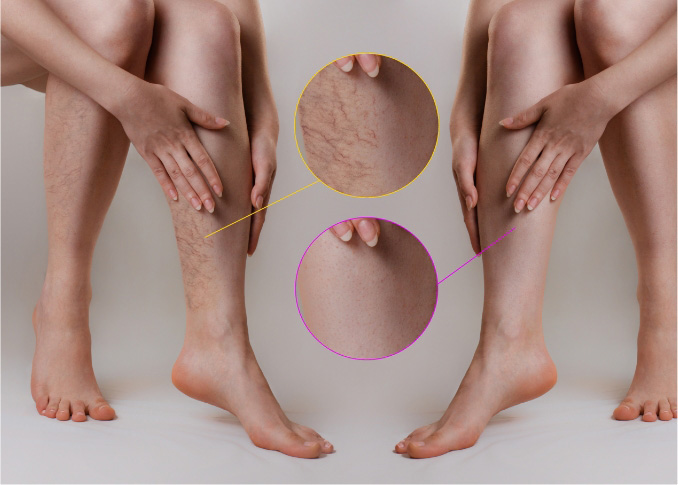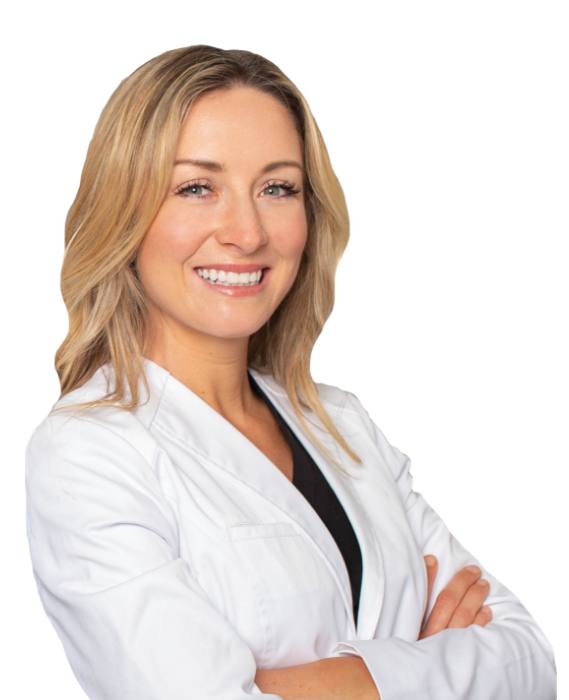Top Long Island Vein Doctors
What is the Treatment for Varicose Veins?
What is the treatment for varicose veins?
Varicose veins are dense leg veins that bulge out of the skin’s surface in a twisted and knotted form. They’re essentially dilated blood vessels with excessive blood accumulation, caused by a circulatory disorder known as chronic venous insufficiency. Healthy leg veins contain valves that act as one-way doors, ensuring blood circulation towards the heart, often against the force of gravity. Venous insufficiency is a medical condition wherein the vein valves collapse and blood flows backward, eventually accumulating in the leg veins. The continued accumulation of blood in leg veins leads to spider veins and varicose veins.
If you have spider veins and varicose veins, you must contact a state-of-the-art vein treatment clinic in Long Island for diagnosis and treatment. Our board-certified vein doctors examine your leg veins and perform thorough diagnostic tests to determine if you have chronic venous insufficiency, following which we curate a personalized vein treatment plan. We always treat the underlying chronic venous insufficiency before addressing the superficial varicose veins. Removing varicose veins without treating the underlying vein disease would increase the risk of recurrence — the varicose veins will simply return.
If you have spider veins or varicose veins, please schedule an appointment at our vein treatment clinics in Long Island. Below, we provide an overview of your varicose vein treatment options.
Radiofrequency Ablation
Radiofrequency ablation is one of the most popular minimally invasive treatments for varicose veins. The vein doctor makes a small incision on the skin’s surface and drives a catheter, under ultrasound guidance, into the diseased saphenous vein. When activated, the catheter generates radiofrequency waves to collapse the problematic vein, and the accumulated blood reroutes into healthier leg veins.
Endovenous Laser Ablation
Endovenous laser ablation is one of the most effective minimally invasive procedures for chronic venous insufficiency. The vein doctor makes a small incision on the skin’s surface and drives a laser fiber, under ultrasound guidance, into the problematic saphenous vein. When activated, the laser fiber generates laser energy to destroy the diseased vein, rerouting the accumulated blood into healthier leg veins.
VenaSeal
VenaSeal is one of the latest FDA-approved treatments for varicose veins and vein disease. The vein doctor injects a medical-grade adhesive, essentially a vein glue, into the diseased saphenous vein under ultrasound guidance. The vein glue seals the diseased vein’s walls, turning it into a hardened tissue eventually absorbed by the body. The accumulated blood reroutes into healthier leg veins.
ClariVein
ClariVein, also known as mechanochemical ablation, combines two forces to treat extremely twisted and large varicose veins — mechanical energy and sclerosant medicine. The vein doctor makes a small incision on the skin’s surface to insert a specialized catheter with a rotating tip into the diseased vein. When activated, the catheter’s rotating tip damages the vein walls while injecting sclerosant medicine, which fuses its walls, turning it into a hardened tissue eventually absorbed by the body. The accumulated blood reroutes into healthier leg veins.
Sclerotherapy
Sclerotherapy is widely considered the best spider vein treatment. This is a cosmetic treatment, which means it can only remove the visible spider veins without addressing the underlying chronic venous insufficiency. The vein doctor injects a medicine called sclerosant into the spider veins to fuse their walls, turning them into hardened scar tissues. The spider veins gradually shrink, harden, and get reabsorbed by the body. The accumulated blood flows into healthier leg veins.
Foam Sclerotherapy
Foam sclerotherapy is a modified version of sclerotherapy, suitable for large varicose veins rather than spider veins. The vein doctor mixes some of the sclerosant solutions with air, turning it into a foamy mix. The foamy sclerosant medicine is injected into the superficial varicose veins on the skin’s surface. Since foam covers more area than liquid, the sclerosant medicine effectively covers the entire varicose veins, making them shrink and get reabsorbed by the body.
Ambulatory Phlebectomy
Ambulatory phlebectomy, also known as microsurgery, is one of the most effective and reliable treatments for superficial varicose veins. The vein doctor administers local anesthesia and makes small incisions on the skin’s surface, through which the varicose veins are physically extracted. The incision marks gradually heal and fade away from the skin’s surface. This cosmetic procedure for varicose veins produces instant results.
What is the best and safest treatment for varicose veins?
All minimally invasive spider vein and varicose vein treatments are equally safe and effective. They have a 97% success rate and a negligible risk of complications. At most, you may experience some post-treatment soreness, swelling, and discomfort for a few days. The vein doctor will also perform allergy tests to ensure you don’t have a negative reaction to the sclerosant medicine or vein glue.
How can I get rid of varicose veins without surgery?
Minimally invasive spider vein and varicose vein treatments allow you to get rid of varicose veins without surgery. Minimally invasive procedures are performed under local anesthesia, and they only involve one small incision on the skin’s surface. They’re more effective and safer than surgical treatments for varicose veins, such as vein ligation and vein stripping. You should only contact vein doctors specializing in minimally invasive spider vein and varicose vein treatments.

We know health insurance is confusing so we will help you check if you’re covered:
FREE Coverage Checker:
What is the latest treatment for varicose veins?
VenaSeal is one of the latest treatments for varicose veins — it has only recently received FDA approval. While VenaSeal is an extremely effective and safe treatment, its long-term effects aren’t as well studied as some of the other minimally invasive vein treatments. Furthermore, it’s not always covered by all medical insurance plans. Please contact our board-certified vein doctors in Long Island to identify the ideal vein treatment plan for yourself.

Visit Our Long Island Vein Treatment Center
Long Island
Vein Specialists
Meet your Long Island NY Vein Doctor
With Harvard Trained Medical Directors, our vein clinic Long Island sources only the top spider and varicose vein experts in the country.


Change your life
Join thousands of happy patients just like you
Vein treatments are often covered by major medical insurances, including Medicare. How do you know if your insurance will cover your vein treatment?
Contact us
CALL US
Speak with one of our team members to ask any questions you may have, verify your insurance and book an appointment at your earliest convenience. (631) 629-1118
BOOK APPOINTMENT
You can give us a call at (631) 629-1118 or fill out one of our forms here to request a call back; one of our team members will call you and help you verify your insurance coverage before booking your appointment.
Get directions
Visit us at our Long Island Vein Treatment Center located at 481 West Montauk Highway.